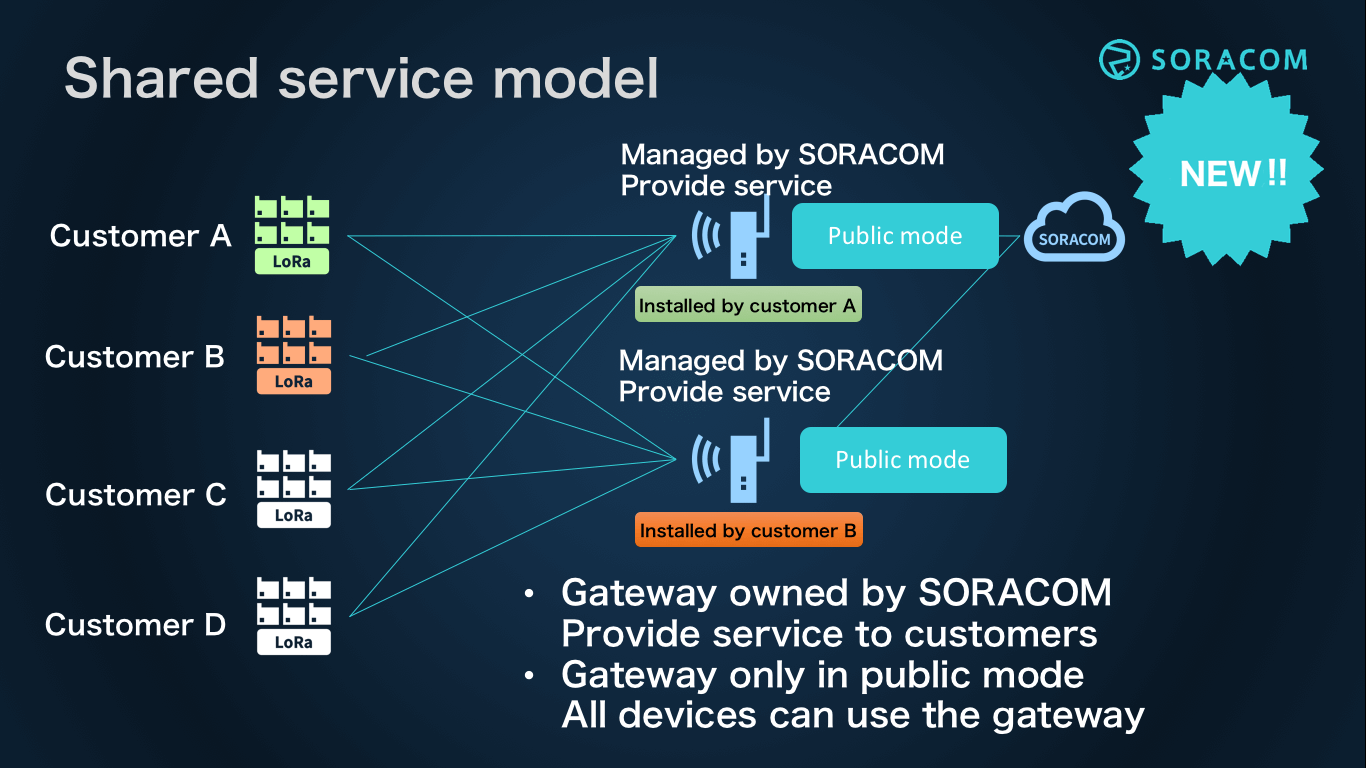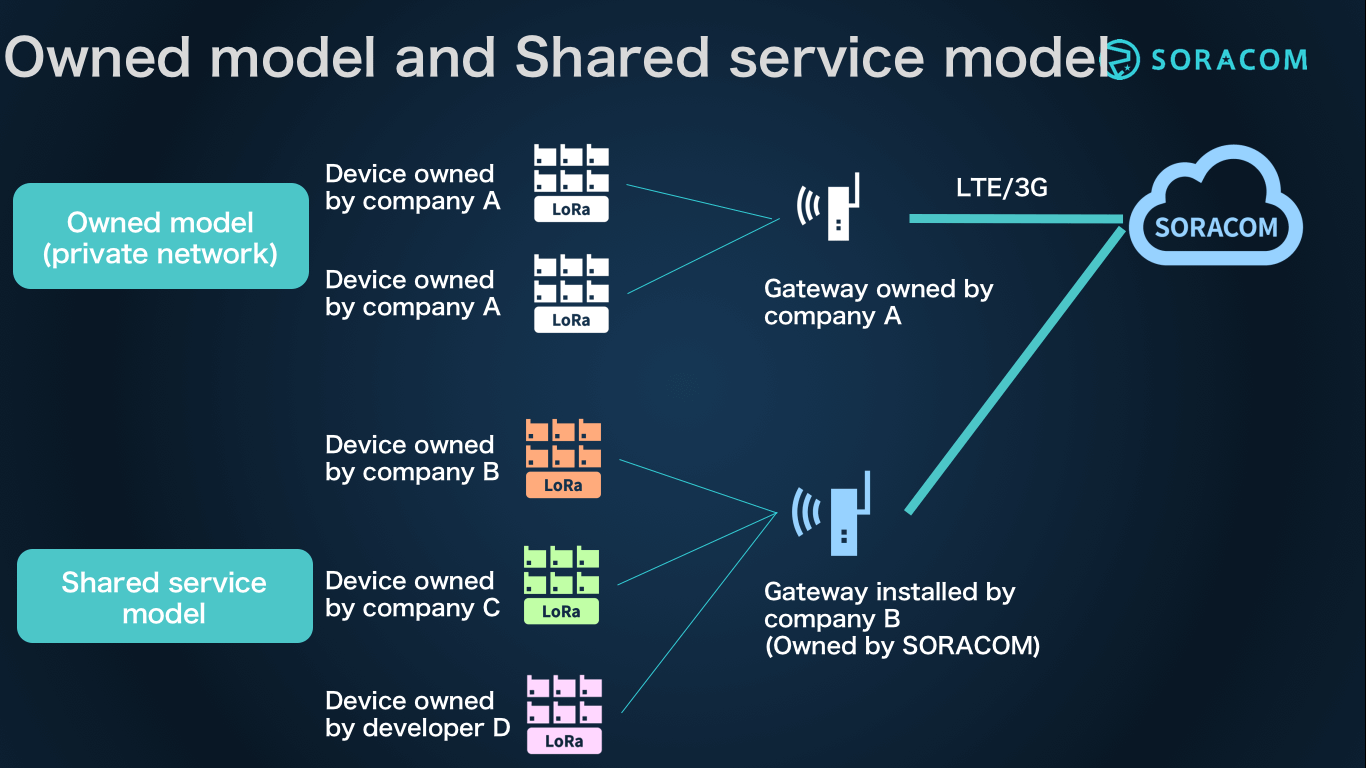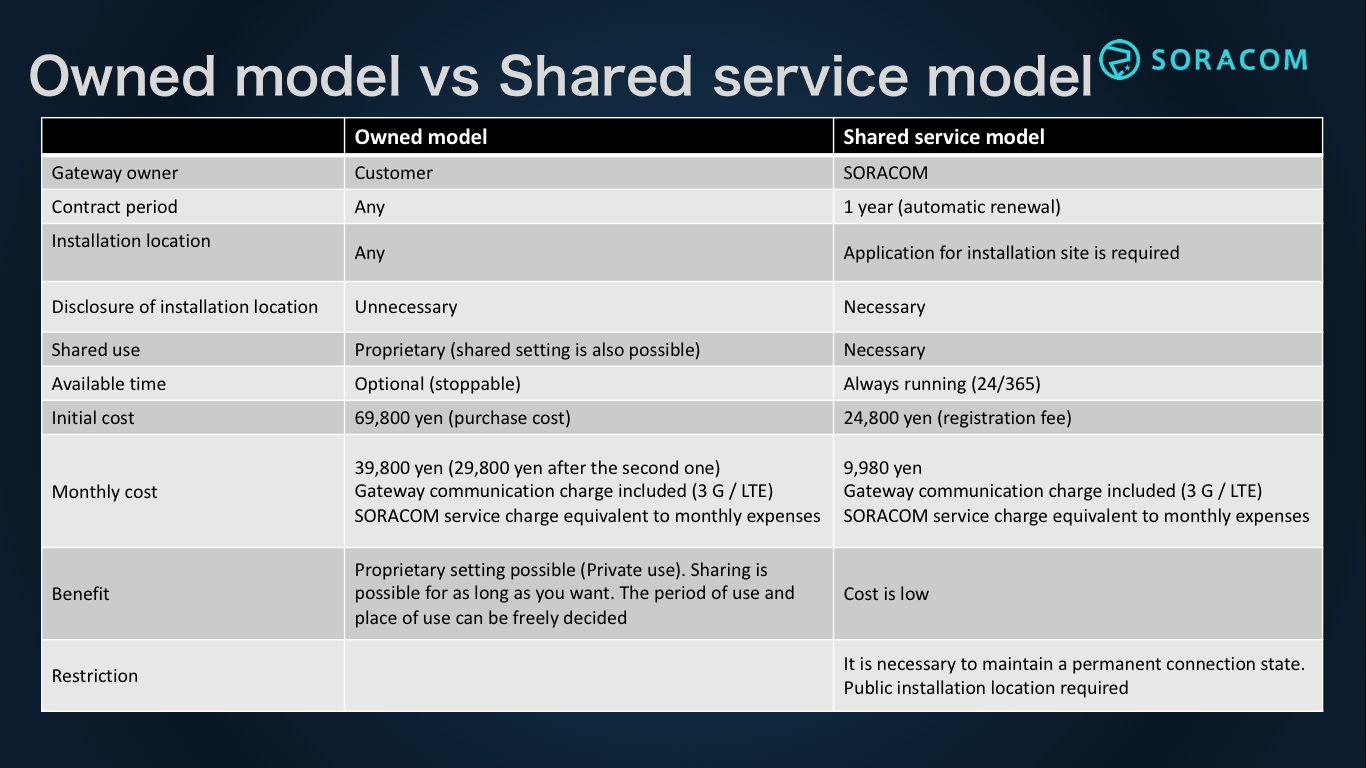Soracom launches LoRaWAN support in a shared economy model

Introduction
On February 7, 2017, we held the SORACOM LoRa Conference in Tokyo and announced a lot of new services in the keynote, including a new sharing model for LPWA. In this blog post, I will explain the points of the new presentation by extracting some keynote materials.

Aiming for a LPWA sharing economy
LoRaWAN is a new and very interesting technology: because the LoRa wireless specification uses unlicensed spectrum, like Wi-Fi, anyone can use it, and anyone can set up a LoRa gateway (base station), anywhere. The low-power spec doesn’t move data quickly, but it allows a single gateway to cover an area of several kilometers or more, even in urban environments. Soracom has now officially launched LoRaWAN support, so anyone can purchase a LoRa gateway and LoRa device and quickly create a private LoRa network anywhere. We will call this the owned gateway model.
The owned gateway model is convenient and secure. With an owned gateway, you can build a private network by yourself, and because your gateway is set to private by default you can ensure that you are the only user.
At the same time, the subgiga band (920MHz) that LoRaWAN uses is a valuable finite resource. Unlike Wi-Fi, LoRa signals travel over several kilometers or more. So if everyone sets up their own LoRa gateway, even though they can’t decrypt private data, they can cause interference.
Therefore, it is better for a sustainable society to apply the sharing economy concept rather than owned, which is the reason for this announcement.
Shared-gateway model released
Today, we are announcing a shared service model for LoRa as a new initiative, aiming at supporting a sustainable sharing economy for LPWA alongside the owned-gateway model.

In this model, we will install SORACOM-owned LoRa gateways at properties owned by “LoRa as a Service” customers (LaaSers?). Since these gateways will be set to public mode, they will be useable not only by the requesting customer but by other LoRa devices within range as well. In other words, as a LoRa sharing customer, you can reduce your cost by using a SORACOM-owned gateway, and share the benefit with other LoRa developers. Many customers will use this shared service model, and gateways that can be used by all customers will increase all over the country.
By the way, although it will be a technical story, since the gateway will receive everything as a radio wave anyway, it does not matter whether it is private or public, the bandwidth of the backhaul of this gateway is provided by a SORACOM-sponsored line. The limitation of the processing capacity of the gateway does not occur unless the number of LoRa devices and transmissions is quite large.

The key difference between the owned-gateway model and the shared service model is whether or not other customers can send data via that gateway.
For owned models, other customers can not send data via the gateway. In the shared service model, since the gateway owned by SORACOM is provided as a service, all customers within range of this gateway can send data from the LoRa devices.
Announcement of SORACOM LoRa Space
Furthermore, in order to clarify where this shared gateway is located, we have also opened a website called SORACOM LoRa Space. Here you can check the gateway that is in public mode on the map, so you can send data on the LoRa device from within that area.
Sharing service model usage fee
The usage fee of the shared service model is as follows. (With apologies to our customers outside of Japan, prices are in yen since Japan will be our first market for this service.)
The initial cost of a LoRa indoor gateway is 24,800 yen. Monthly usage fee is 9,980 yen as above, but includes the usage fee of SORACOM Air for LoRaWAN (device management at the console, gateway management etc.) and the cellular fee of the gateway.
In addition, you can use the same amount of the monthly fee as SORACOM application service usage fee. It can be used for most of the next LoRa device usage fee.
LoRa device usage fee
The usage fee for SORACOM Air for LoRaWAN of LoRa device is… completely free, actually. In the case of this Arduino development shield, the initial purchase cost will be 7,980 yen.
Since the usage fee of SORACOM application service is the same as usual usage fee, sending from a LoRa device using Beam is 0.0018 yen per request. For example, if it is a use case sending data once a day, if you calculate it for a month, it will be 0.054 yen and you can use the LoRa device at a very cheap rate.
Trial calculation by use case
Let’s estimate usage fees for a few use cases (not including initial costs such as initial registration fee and device purchase cost). In this shared service model, as long as the LoRa device doesn’t send a lot of data, the gateway usage fee becomes the dominant cost, so the monthly cost example changes depending on how many devices are used per gateway.
For example, in the case of 500 units per gateway, like a trash can, it is 19.9 yen per device. On the other hand, when measuring water meter with 300 device per the gateway in a medium-sized city, it will be 3.32 yen per month, 39.84 yen per year, very small amount .
In special cases, for example surveillance lighting that sends data every few minutes, since it exceeds the SORACOM application service usage fee attached to the gateway, the monthly cost per device is 80.3 yen.
Owned-gateway LoRa model vs Shared service model

This is a table comparing owned model and shared service model.
Since owned models are fully controlled by their owners, this model is highly flexible with respect to contract term, installation place, private setting or sharing setting, and availability.
The shared service model requires publication of the installation site as a gateway to be used by everyone, so it is cheap as a usage fee due to the public mode, but you do have to keep the power on.
Summary
This shared service model is a truly unique model, based on a long-term world vision for a sustainable society moving from ownership to use. Moreover, it is very consistent with SORACOM’s vision of a truly connected world, without limits.
We want to see LoRaWAN become even more popular, and hope that this will only be the beginning of new innovations coming out of Japan to grow IoT around the world.
We are planning to expand the offering of SORACOM-compatible LoRa gateways and devices for partners in the future, so please look forward to it!
Ken Tamagawa




